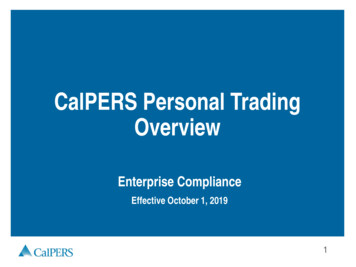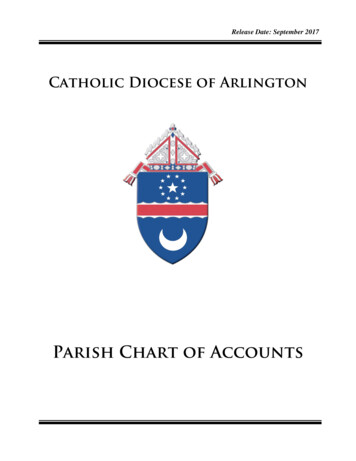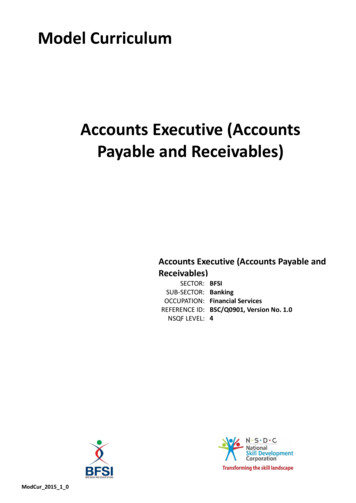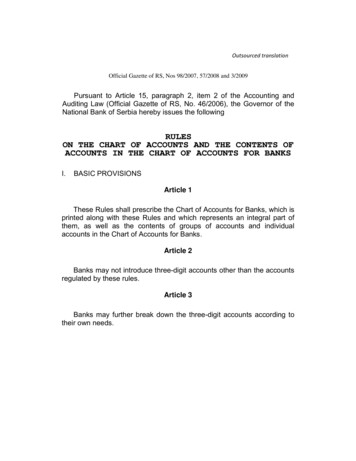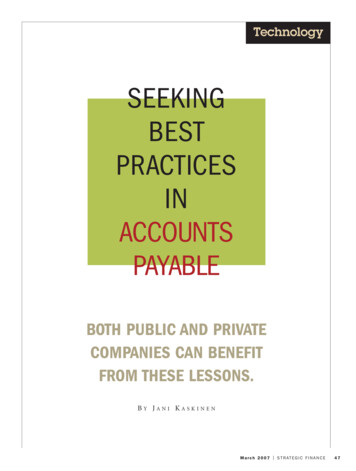
Transcription
H PUBLIC AND PRIVATECOMPANIES CAN BENEFITFROM THESE LESSONS.BY JANI KASKINENMarch 2007IS T R AT E G I C F I N A N C E47
ere it is almost five years after the SarbanesOxley Act (SOX) was passed, and the feedback is still mixed. Several surveys haveshown how it has made some companiesmore efficient, yet complaints about theexcessive costs of compliance are rampant. And achievingcompliance is quite a challenge, especially since SOXdoesn’t provide a road map on how to get there.But SOX has provided some benefits. It has forcedcompanies to improve corporate governance, provideenhanced accountability and transparency, find andreduce waste, and eliminate opportunities for fraud. Atthe same time, however, many companies have experienced the downside of SOX: time-consuming, demanding, and costly processes.Now it’s time to step back and assess the lessonslearned. Best practices have emerged in SOX compliance,but until now there has been little focus on the accountspayable (AP) area in general and invoice processing inparticular. By recognizing lessons learned in AP andapplying best practices, companies can improve theirability to be compliant, benefit from improved processes,and minimize costs. Let’s look at some of the valuablelessons learned.HLESSON 1: POLICIES WITHOUTCONTROLS WON’T WORKOne of the critical lessons many of us have learned aboutcompliance is that policies and procedures aren’t enough.Despite all the efforts companies have undertaken overthe past few years to establish stringent financial policies,many still lack effective ways to document and enforceinternal controls.Accounts payable is a critical area for SOX compliance because that’s where financial commitments aremade and outbound cash flow is regulated. Companiescan’t manage their cash flow and spending effectivelyunless they have real-time access to this information.This is critical for all companies regardless of the number of invoices they process per year. Obviously thisissue becomes more critical as spending and the numberof invoices processed per year increase. Companies mustbe able to know where invoices are within the process,how many invoices are being processed, and their totalliabilities.It isn’t enough to have internal policies without theinternal controls in place to ensure that the rules arebeing implemented properly. For example, you need to48S T R AT E G I C F I N A N C EIMarch 2007have a way of ensuring that only employees with theproper level of approval are in fact approving invoices.You need to be able to record every invoice that comes in,know where any particular invoice is at any given time,know who touched each invoice, and know what actionshave been taken.A large, decentralized company that receives invoices inseparate locations has little control over this process. Ifsomeone is away or doesn’t submit invoices in a timelymanner, the invoices can be sitting on a desk withoutanyone else knowing. It then becomes difficult, if notimpossible, for headquarters to know how much moneyit needs to set aside for payments. The company alsomisses out on another bottom-line benefit: the ability tonegotiate early-payment discounts as well as avoid latepenalties. In the case of fraud, someone could submitinvoices to separate divisions for the same work. Thecompany has lost control of and visibility into theprocess, and cash flow and spend management have beencompromised.Invoices without purchase orders (POs) pose additional problems that only increase as their volume grows. Forexample, companies that process 25,000–30,000 invoicesper month and hundreds of thousands of invoices peryear could have a staggering number of non-PO-basedinvoices. If they aren’t routed to Accounts Payable in atimely manner—within 30 days—the company can’taccurately report expenses, which could be a huge problem at the end of the quarter. Taken to the extreme, alarge number of unrecorded liabilities could force a company to restate earnings and impact its credibility.
ACCOUNTS PAYABLE is a critical area for SOX compliancebecause that’s where financial commitments are madeand outbound cash flow is regulated.LESSON 2: POLICIESCOMBINED WITH TECHNOLOGY RULES ENFORCEMENTTechnology is recognized as a critical component inachieving SOX compliance, and companies can leverage itto effectively enforce the policies they have established.For example, an automated invoice processing systemwon’t allow anyone without the proper approvals toapprove an invoice. The system will capture each invoiceas soon as it is received—including those without purchase orders—and time stamp each action that occurs. Itwill create an audit trail that enables companies to havevisibility and control over the entire invoicing process.Technology also enables companies to conduct accurate reporting in a fraction of the time it takes withmanual methods. You can look at invoice processing datain any number of ways, such as viewing cost codes, out-manual recordkeeping didn’t enable such exact analysissince it was impossible to track and factor in allunrecorded liabilities.Some sophisticated companies implement Shared Service Centers (SSCs), centralized hubs for handlingadministrative, financial, and other services across theentire organization. An Accounts Payable SSC enablescompanies to streamline costs and, more importantly, toimplement best practices across the enterprise. It providescentralized control, consistency, and visibility across alarge, dispersed organization.When it comes to doing business globally, SOX compliance becomes a more difficult issue. A company needsto ensure that all of its subsidiaries are implementingcontrols and processes in the same way. It also needs tohave real-time visibility into the system, regardless of themultitude of languages and currencies involved. Largeglobal companies are benefiting from SSCs by centralizing and implementing best practices throughout thecompany, making processes consistent and visibilityimmediate.LESSON 3: FIND WAYS TOREDUCE COSTSstanding payments that need to be made, time from processing to payment, and the individuals who processedinvoices. When it comes to audits, you no longer have tosearch through files to find a specific invoice because allthe information is available at a moment’s notice, andaudits that used to take weeks can now be completedwithin days. Technology also enables companies toimprove their working capital management abilities.Cash management can now be done more proactivelysince all the information is centrally available, whereasIn the past few years, efficiency and cost effectivenesstook a back seat while companies scrambled to establishpolicies and systems to ensure compliance. Now it’s timefor organizations to look for ways they can save time andmoney so they can improve their bottom line.Manual invoice processing is an extremely timeconsuming and, therefore, costly process that involves: Checking invoices against the purchase orders; Making sure that the price, quantity, and goods matchthe PO and that all the information on the invoice iscorrect; Determining the proper approver and routing theinvoice to that person; Tracking the invoice to ensure that it comes back in atimely manner; Inputting, coding, and reviewing the invoice whenMarch 2007IS T R AT E G I C F I N A N C E49
entering it into the accounting system; Coding it again to the right cost center, etc.Automating the process greatly reduces the time ittakes to process an invoice, typically from many weeks ormonths to a matter of days. Once an invoice is availableelectronically (it is either received that way or scannedin), the technology can automatically match it against theorder and route it for payment or route it to the appropriate person and then send it to the AP department forprocessing. Technology also automates the processing ofperiodic or contract-based purchase invoices. Typically,the approval workflow and posting data of these recurring invoices are identical, so it’s ideal to automate them.The system matches the invoice with the contract andtransfers matched invoices directly to Accounts Payable. Ifthe invoice doesn’t match, the system sends it to a predesignated person for approval.When the technology is fully implemented and theappropriate business rules are followed, many invoices nolonger require human intervention. Since the workflow isautomated and the bulk of the invoices are handled bythe system, the AP department is now just dealing withexceptions, which frees up their time to be more strategic.A study by the Aberdeen Group, an industry researchfirm, found that many organizations realized 40% to 60%savings by implementing an appropriate invoice automation solution. They achieved a return on investment(ROI) in a matter of months in many cases, which meantthe system paid for itself in a very quick time frame.On top of these efficiencies, an automated system willenable companies to have more control of and visibilityinto their invoices, as well as save money by obtainingvendor discounts and avoiding late-payment penalties.Also, by gaining control of the spending process, companies can improve their supplier relationships and quitepossibly the terms of their agreements with suppliers.In addition to cost savings, an automated system provides controls for financial accuracy and helps to preventfraud. For example, it will uncover discrepancies betweena PO and invoice, and it will identify duplicate paymentsor invoices coded with incorrect cost centers and ensurethat only those people who are allowed to authorizeinvoices do so.LESSON 4: FIND WAYS TOIMPROVE PROCESSESImplementing a technology solution provides an additional benefit by enabling companies to review and50S T R AT E G I C F I N A N C EIMarch 2007streamline current processes. AP departments shouldlook at how they are currently handling invoice processing. Consider the following areas: Capture: How is the information getting into the system? How can you avoid manual entry? How are yougetting the data you need out of ERP systems? Processing: How many people need to look at aninvoice? How is it being coded? How are you handlingthe routing so the invoice only gets to the appropriateapprovers? How are you building in a way to ensurethat the invoices get routed and processed in a timelyfashion? Reporting: What type of reports do you need? Howcan you enable the reports to address these needs?How can you make reporting easy and fast?It makes no sense to automate a broken process. Afteryou evaluate your current methods, determine whatprocesses need to change to enforce your policies moreeffectively. Consider how you can streamline theseprocesses to reduce time and costs and achieve betterresults. Then you can think about automation.LESSON 5: IMPLEMENT KEYPERFORMANCE INDICATORSTO ATTAIN CONTINUALIMPROVEMENTSOX regulations require that companies demonstratecontinual improvement, but they must figure out how toaccomplish this. In order to accurately determine andimplement improvements, they must first put a systemof measurement in place. One effective approach is todetermine the key performance indicators (KPIs) for thepurchase-to-pay (P2P) processes. The AP departmentshould select the indicators that they want to assessbased on their business goals. For example, a companymight want to measure the cost of processing an invoice,the interval between when an invoice is received andwhen it is processed, etc. Once these criteria are determined and measured against current practices, the company should then reevaluate these measures afterimplementing a technology solution. They should measure the improvements achieved over the previous system and against industry benchmarks. This will enablecompanies to continually monitor and adjust theimprovements they are making to their processes andweigh these improvements against the effort it takes toimplement them.
LESSON 6: ENSURE THESYSTEM HAS FLEXIBILITYBEYOND SOXIn addition to SOX, there are other U.S. regulations thatcompanies need to follow, such as the Patriot Act, HealthInsurance Portability and Accountability Act (HIPAA),Gramm-Leach-Bliley Act (GLBA), and Federal Information Systems Management Act (FISMA), as well as standards such as Payment Card Industry Data SecurityStandard (PCI DSS), Control Objectives for InformationTechnology (CobiT), and Committee of SponsoringOrganizations of the Treadway Commission (COSO)guidelines. There are also many other country-specificregulations companies have to contend with when doingbusiness overseas, such as Basel II.Look for efficiencies. Make sure that the time, effort,and cost you are investing to achieve SOX compliancewill also accommodate other compliance needs. Whenimplementing an automated Accounts Payable system, forexample, make sure that it provides effective controls andvisibility as well as the flexibility to adapt to and addressany other required regulations.LESSON 7: MAKE ACCOUNTSPAYABLE MORE STRATEGICAccounts Payable departments are always looking forways to provide added business value by becoming lesstransactional and more strategic. An automated invoiceprocessing system will help them accomplish this bystreamlining processes and providing efficiencies. Sincethe system’s technology will process the majority of anorganization’s invoices, AP staff will primarily handleexceptions and will have time to focus on the morestrategic aspects of AP, such as analyzing data and gener-ating dynamic reports from the system to provide line-ofbusiness management with up-to-date key information insuch areas as spend analysis and cash flow management.This critical, real-time access to business information willhelp run the business more profitably. As I mentionedearlier, AP management can also manage payments morestrategically, evaluating payment schedules based on thepenalties and discounts attached to them. For example, adiscount for early payment for one invoice might bemuch greater than the penalty that the company wouldincur for paying another one late. A strategic AP department will be able to manage the priority and timing ofinvoice payments based on late-payment penalties orearly-payment discounts.LESSON 8: INTEGRATIONIS KEYCompanies have invested tremendous time and money intheir ERP systems, so it’s imperative that any financialsystem introduced into a company can integrate easilyand seamlessly with existing ERP and accounting systems.For example, information needs to flow quickly andsmoothly to and from an invoice processing solution andback-end ERP system. This ensures that information isconsistent throughout the financial processes and enablesaccurate reporting.Despite having internal controls on paper, many companies lack ways to ensure that these controls are beingfollowed. Best practices in terms of policies and technology will work synergistically in the area of compliance—with technology providing the necessary control toenforce the procedures that have been established. Inaddition to control, automated solutions provideincreased accuracy, visibility, and timely financial reporting capabilities that are required for SOX compliance.With automation, companies can achieve more in theirAP departments and benefit from competitive advantages. Working toward compliance is no longer enough.Companies now must apply the lessons learned and strivefor best practices. Forward-thinking companies are usingSOX compliance to their advantage—improving processes, achieving greater cost savings, and elevating AP to amore strategic level. Jani Kaskinen is vice president of BasWare, Inc., a providerof software solutions that automate the purchase-to-payprocess for enterprises around the world. You can reach himat (203) 487-7905 or jani.kaskinen@basware.com.March 2007IS T R AT E G I C F I N A N C E51
enced the downside of SOX: time-consuming, demand-ing, and costly processes. Now it's time to step back and assess the lessons learned. Best practices have emerged in SOX compliance, but until now there has been little focus on the accounts payable (AP) area in general and invoice processing in particular. By recognizing lessons learned in AP and
